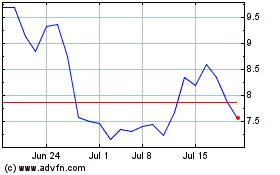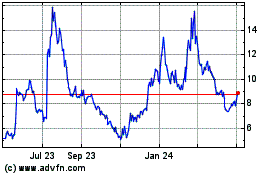Recursion (Nasdaq: RXRX) reported initial monotherapy
dose-escalation data from the Phase 1/2 study (ELUCIDATE) of
REC-617, a selective CDK7 inhibitor, in advanced solid tumors.
These results were presented today after market close at an AACR
Special Conference in Cancer Research. The company will also hold a
webinar on December 10 at 6:30 AM MT / 8:30 AM ET / 1:30 PM GMT to
present the preliminary data broadcast from Recursion’s X (formerly
Twitter), LinkedIn, and YouTube accounts with an opportunity to
submit questions here.
"Cell cycle dysregulation and transcriptional 'addiction' are
both hallmarks of many aggressive cancers," said David Hallett,
Ph.D., Chief Scientific Officer of Recursion. "By inhibiting CDK7,
we have the potential to target both mechanisms while fine tuning
the therapeutic index. Using our precision design platform, we
created a molecule with rapid oral absorption to reduce GI tissue
exposure, a suitable half life to manage side effects, and target
engagement covering the IC80 level."
ELUCIDATE is an ongoing Phase 1/2 study evaluating the safety,
tolerability, pharmacokinetics (PK), pharmacodynamics (PD), and
maximum tolerated dose (MTD) of REC-617 in patients with advanced
solid tumors. As of the November 15, 2024 data cutoff, preliminary
findings include 18 patients with advanced solid tumors who were
response evaluable in the monotherapy dose-escalation phase. Doses
ranged from 2 mg to 20 mg once daily (QD) and 1 mg twice daily
(BID).
REC-617 was generally well-tolerated across all dose levels,
with no discontinuations due to adverse events (AEs). Adverse
events to date were predominately Grade 1-2, on-target, and
reversible. An MTD has not yet been reached.
While efficacy was not an endpoint in this Phase 1 study, or
anticipated in monotherapy, a confirmed durable partial response
(PR) by RECIST on REC-617 monotherapy was achieved in a patient
with metastatic, platinum-resistant ovarian cancer. The response is
on-going after more than 6 months of treatment. This patient had
progressed following 4 lines of prior therapy in the advanced
setting. In addition, four patients achieved a best response of
stable disease (SD) across multiple dose levels for up to 6 months
of treatment.
"These initial findings for REC-617 represent an exciting step
forward in the development of CDK7 inhibitors, with a favorable
PK/PD profile and a durable confirmed partial response observed in
dose escalation in a highly pre-treated patient population," said
Najat Khan, Ph.D., Chief R&D Officer and Chief Commercial
Officer, Recursion. "Designed using our AI-powered OS platform,
REC-617 reflects our focus on enhancing the therapeutic index to
deliver more effective and safer treatment options for patients. We
are eager to continue this momentum in dose escalation and to
initiate the next phase of the program next year."
In parallel to the ongoing monotherapy dose escalation (QD and
BID), combination studies are expected to initiate for ELUCIDATE in
H1, 2025. The company expects to present additional ELUCIDATE as
well as preclinical REC-617 data at future medical meetings.
Summary of Interim REC-617 Monotherapy Dose Escalation
Results
Study Design & Demographics
- Phase 1 monotherapy dose escalation in advanced solid
tumors
- Data cutoff as of November 15, 2024 - 19 patients enrolled (18
response evaluable)
- Heavily pre-treated population (median of 4 prior lines of
therapy in the advanced setting)
- Antiemetics and anti-diarrheals not mandated
prophylaxis for nausea/vomiting/diarrhea
PK/PD Summary
- REC-617 exceeds CDK7 IC80 with rapid absorption (Tmax 0.5–2
hours) with a half-life of 5-6 hours
- Early POLR2A 3-4x modulation suggests ~80–90% target
engagement
- Quick, time-limited target engagement with POLR2A normalization
in 24 hours
- Twice-daily (BID) dosing under investigation
Safety Profile/AE Summary
- Adverse events (AEs) were predominantly low grade, on-target,
and reversible upon treatment cessation
- Early data indicates a favorable safety profile – maximum
tolerated dose (MTD) not reached
- No treatment discontinuations due to AEs
- 3 treatment related serious adverse events (SAE)s reported in
2/19 patients
- Events resolved and treatment continued after dose
reduction
- Antiemetics and anti-diarrheals not mandated prophylaxis for
nausea/vomiting/diarrhea
Confirmed Partial Response & Stable Disease Summary
- One confirmed partial response (PR) by RECIST 1.1 (decrease of
more than 30% in the sum of the longest diameters of target lesions
+ no new lesions + no progression of non target lesions)
- Partial response (-34%) achieved with reduction of 2 lymph
nodes (para-aortic and mesenteric) at Week 16 with normalization of
LDH
- Reduction of tumor marker CA125 from 1249 to 694 kU/L
(-44%)
- Reduction of tumor marker TK1 from 174 to 56 DuA (-68%)
- Response ongoing after more than 6 months of
treatment
- Patient continues study therapy without need for
antiemetics
- Four additional patients achieved durable (up to 6 months of
treatment) response of stable disease (SD) as best response across
multiple dose levels
- All four patients progressed prior to entering the study
- Three CRC patients (6L-7L) and one NSCLC patient (4L)
- One patient on 2mg QD and three patients on 10mg QD
About REC-617REC-617 is a potential
best-in-class CDK7 inhibitor, precision designed using AI-led
approaches, with only 136 novel molecule synthesized from hit
to candidate identification in less than 12 months. The molecule is
designed to maximize its therapeutic index by enabling the tight
control of both the extent and duration of target inhibition. CDK7
inhibition combines many potential benefits such as transcription
inhibition, reduction of aberrant kinome activation, cell cycle
inhibition, and modulation of estrogen receptor activity. This
makes it an attractive target to overcome common resistance
pathways associated with CDK4/6 inhibition, which only targets the
cell cycle.
About ELUCIDATEREC-617 is currently being
evaluated as a monotherapy in the ELUCIDATE trial. ELUCIDATE is a
multicenter, open-label, two-stage clinical trial to evaluate
safety, pharmacokinetics, pharmacodynamics, and efficacy of REC-617
in advanced solid tumors, including non-small cell lung cancer
(NSCLC), colorectal cancer, breast cancer, pancreatic cancer,
ovarian cancer, head and neck cancer.
Both the monotherapy and combination therapy dose escalation
portion of the trial will enroll patients across multiple dose
levels to determine the optimal biological dose (OBD). The dose
expansion phase of the trial will commence upon identification of
the OBD. The primary efficacy endpoint of the expansion phase is
objective response rate (ORR).
About RecursionRecursion (NASDAQ: RXRX) is a
clinical stage TechBio company leading the space by decoding
biology to radically improve lives. Enabling its mission is the
Recursion OS, a platform built across diverse technologies that
continuously generate one of the world’s largest proprietary
biological and chemical datasets. Recursion leverages sophisticated
machine-learning algorithms to distill from its dataset a
collection of trillions of searchable relationships across biology
and chemistry unconstrained by human bias. By commanding massive
experimental scale — up to millions of wet lab experiments weekly —
and massive computational scale — owning and operating one of the
most powerful supercomputers in the world, Recursion is uniting
technology, biology and chemistry to advance the future of
medicine.
Recursion is headquartered in Salt Lake City, where it is a
founding member of BioHive, the Utah life sciences industry
collective. Recursion also has offices in Toronto, Montréal, New
York, London, Oxford area, and the San Francisco Bay area. Learn
more at www.Recursion.com, or connect on X (formerly Twitter) and
LinkedIn.
Media ContactMedia@Recursion.com
Investor ContactInvestor@Recursion.com
Forward-Looking Statements
This document contains information that includes or is based
upon “forward-looking statements” within the meaning of the
Securities Litigation Reform Act of 1995, including, without
limitation, those regarding the potential efficacy of REC-617;
timing of the Phase 1/2 clinical trial of REC-617; early and late
stage discovery, preclinical, and clinical programs; licenses and
collaborations; prospective products and their potential future
indications and market opportunities; Recursion OS and other
technologies; business and financial plans and performance; and all
other statements that are not historical facts. Forward-looking
statements may or may not include identifying words such as “plan,”
“will,” “expect,” “anticipate,” “intend,” “believe,” “potential,”
“continue,” and similar terms. These statements are subject to
known or unknown risks and uncertainties that could cause actual
results to differ materially from those expressed or implied in
such statements, including but not limited to: challenges inherent
in pharmaceutical research and development, including the timing
and results of preclinical and clinical programs, where the risk of
failure is high and failure can occur at any stage prior to or
after regulatory approval due to lack of sufficient efficacy,
safety considerations, or other factors; our ability to leverage
and enhance our drug discovery platform; our ability to obtain
financing for development activities and other corporate purposes;
the success of our collaboration activities; our ability to obtain
regulatory approval of, and ultimately commercialize, drug
candidates; our ability to obtain, maintain, and enforce
intellectual property protections; cyberattacks or other
disruptions to our technology systems; our ability to attract,
motivate, and retain key employees and manage our growth; inflation
and other macroeconomic issues; and other risks and uncertainties
such as those described under the heading “Risk Factors” in our
filings with the U.S. Securities and Exchange Commission, including
our Annual Report on Form 10-K and Quarterly Reports on Form 10-Q.
All forward-looking statements are based on management’s current
estimates, projections, and assumptions, and Recursion undertakes
no obligation to correct or update any such statements, whether as
a result of new information, future developments, or otherwise,
except to the extent required by applicable law.
Recursion Pharmaceuticals (NASDAQ:RXRX)
Historical Stock Chart
From Dec 2024 to Jan 2025

Recursion Pharmaceuticals (NASDAQ:RXRX)
Historical Stock Chart
From Jan 2024 to Jan 2025
